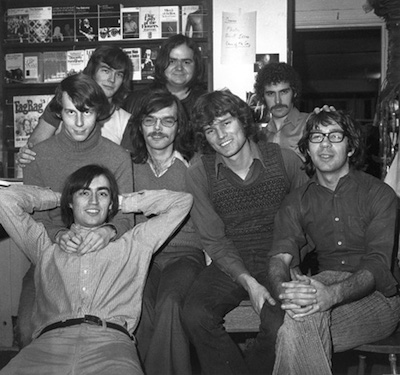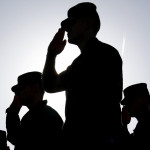 |
| The Body Politic Collective,1972. Photo courtesy of Jearld Moldenhauer |
Though based in New York City, Visual AIDS aims to understand the complexities of HIV/AIDS histories and ongoing issues on an international scale. With Visual AIDS artist members such as Stephen Andrews and Andy Fabo living in Toronto, the city has always been on our radar for its active queer scene. Recently, Toronto’s pioneering queer history was highlighted in a series of site-specific short docs through the Queerstory App. Visual AIDS spoke with Michael Alstad, the brainchild behind Queerstory, about the exciting, interactive application; its relevance to topics surrounding HIV/AIDS; and the importance of site-specific contextualization. We hope other cities will follow Toronto’s lead and create their own apps after the model of Queerstory!
Visual AIDS: Describe the Queerstory App and how the sites were selected.
Michael Alstad: The Queerstory App is an interactive documentary that explores 37 sites significant to Toronto’s LGBT history. The app user can take a self-guided walking tour through the city using the map and GPS on their smartphones and experience 47 site-specific short docs with rare archival footage, hidden stories, in-situ interviews, media art and excerpts of documentaries from queer Canadian filmmakers. After a year of archival research and consultations with the community we chose a selection of sites that resonated with Toronto’s multifaceted queer history--from pivotal events such as the bathhouse raids and riots to more recent histories like the personal stories from Supporting Our Youth’s queer newcomer group, “Express.” It was important for us to be inclusive of a broad spectrum of voices and perspectives on the sites and histories.
Describe the location for a few of the HIV/AIDS specific sites highlighted by Queerstory, such as the location for AIDS Committee of Toronto (ACT) and the AIDS ACTION NOW demo at the Toronto General Hospital, and others.
The locations of the HIV/AIDS specific sites are mostly in the Church & Wellesley neighbourhood--Toronto’s gay village. John Maxwell, executive director of ACT was interviewed in front of the building on Wellesley Street where ACT was officially established in 1983. The interview includes a 30-year visual survey of the posters and brochures from ACT’s groundbreaking campaigns. Nearby on Church Street is Cawthra Park, where the AIDS memorial is located and the annual AIDS vigil is held. The video, which includes interviews with Helen Rykens from The 519 Community Centre and Jocelyn Watchorn from ACT, explores the origins of this important monument and event. Another initiative linked to ACT was the Pussy Palace, located at the site of the present day Oasis Spa at the south end of the village. Founded in 1999 by the Toronto Women’s Bathhouse Committee, it was the first program of its kind to create a safe space to educate women on the risks of HIV/AIDS. The site of AIDS Action Now’s first major demonstration in 1988 was at Toronto General Hospital, located on University Avenue near the University of Toronto. AAN protested the drug trials that delayed the release of an already tested and approved drug to treat AIDS patients suffering from Pneumocystis Pneumonia (PCP). The video includes an interview with AAN founding member Tim McCaskell with some important archival video of the 1988 demo and related media interview by documentary filmmaker David Adkin.
What unique qualities about the Toronto queer scene have you learned through the process of putting together Queerstory?
Putting together Queerstory was an amazing learning experience. I discovered how understated Toronto’s place as a world leader in progressive LGBT policies is--from the first city in Canada to pass an anti-discrimination policy based on sexual orientation to the first city in the world to have a government legitimised same-sex marriage in 2001--politically, socially and culturally the queer community was pioneering. A quality that’s evident across most of the stories was the community’s perseverance in the face of police harassment, censorship, public hostility and discrimination. The personal sacrifice, political commitment and enormous resources required in the fight for equal rights was unprecedented in Canada’s civil rights history. Another notable quality was the sense of unity, both within the community but also to other marginalized communities that were the target of police harassment and violence.
Are there any particularly noteworthy sites, histories or videos that you would like to highlight?
I’d like to highlight the video interviews with John Sewell, mayor of Toronto from 1978-80. Sewell championed gay rights at a time when the community was experiencing heightened intimidation, raids and arrests by the police. Sewell put his neck on the line by calling for the legal protection of gays in his speech at the Freedom of the Press Rally in 1979--an event to protest the police raid and criminal charges against the Body Politic Magazine’s three staff members. Sewell’s speech, as well as his endorsement of George Hislop, the first openly gay candidate for municipal office in Canada, generated a backlash from the local media and the police force.
Some other noteworthy videos are those exploring Toronto’s early queer cultural history in film, theatre, and music. Genderqueer singer Jackie Shane was an essential part of Toronto’s 1960s music scene--his song “Any Other Way” hit No. 2 on the Canadian charts. Winter Kept Us Warm, a film shot at the University of Toronto in the 1965 about two male dorm mates who fall in love, was the first Canadian English language film ever to be screened at Cannes film festival. Fortune and Men’s Eyes is John Herbert’s 1967 autobiographical prison drama exploring gay themes--the play was translated into 40 languages and produced in over 100 countries. The Lesbian Organisation of Toronto, LOOT, was Canada’s first Lesbian Centre--several of its members formed the popular dyke bands Mama Quilla II and No Frills.
An interesting discovery made during my research at the Canadian Lesbian & Gay Archives was through their collection of rare Toronto tabloids--Hush Free Press, Confidential Flash, Justice Weekly--that dated back to the 1940’s. During a period when homosexuality was invisible in the mainstream press the tabloids were full of reports on Toronto’s gay scene--mostly scandalous and sensational stories with a homophobic stance. Ironically these tabloids became a source for gay men and lesbians to find one another as the stories revealed the places and spaces where queers rendezvoused. One of these sites was the lesbian bar The Continental in Chinatown where the tabloids reported on “mannish women congregating” and “gorilla girls rioting.” Despite these sensationalised and sometimes erroneous stories, the tabloids have proven to be a valuable resource--when decoded--for queer historians and researchers.
What can queer communities learn from an attention to site-specificity and hidden queer histories?
An important process in the production of Queerstory was the in-situ interviews. We noticed a pattern with our interviewees--that being situated in the sites where the histories occurred triggered their memory with renewed insights and reflection on the events. I think the process of walking through the city and exploring these sites is an experiential and fun way of discovering and learning about queer history. One good example of a significant queer site that could easily be overlooked is the City Park Co-op--through high density urban planning and architecture the three building apartment complex, opened in the 1954, appealed to single young gays and drew a critical influx of queers to the neighbourhood which eventually led to the formation of the gay village. Another obscure site linked to hidden queer histories is 4 Kensington Avenue an old Victorian house in Toronto’s colourful Kensington Market that housed a collective or writers and activists that formed the basis of Toronto’s key queer orgs.
I see the Queerstory App as a type of “digital plaque” that commemorates and preserves queer history and allows for a more multidimensional and sensory-based experience of lived history as it relates to the urban environment. The site-specific element is especially important in a city that’s undergoing an unprecedented building boom where neighbourhoods have been completely transformed by new development. Several of the Queerstory locations, including the Barracks site where we interviewed Andy Fabo (a Visual AIDS artist member), and the site of the old St. Charles Tavern, are slated for demolition to make way for condominium developments.
How do you hope people will interact with Queer Story and what do you hope people will take away from it?
With 37 locations to traverse through, the Queerstory App tour might be a challenge to explore in one continuous walk but I hope people will take time to experience the complete tour. Several site “clusters” emerged--Kensington Market area/UofT, King Street East/Old Toronto and the gay village--so the tour can be geographically segmented into smaller mini-tours. Also for those without smartphones the videos can be viewed on the Queerstory website and sorted by subject--art & culture, community, activism and bars. We encourage the public to leave comments, personal stories and reflections about the histories on the Queerstory YouTube channel. We also encourage educators to take advantage of the Queerstory App as a teaching resource for students and LGBTQ youth.
Michael Alstad is an artist and independent curator working in installation and digital media with a focus on architectural and public space. His work encompasses a diverse range of media including video, installation, photography, locative media and research-based practice. Michael is a founding member of the Canadian artist collective Year Zero One, where he has curated numerous projects in the past decade.







Comments
Comments